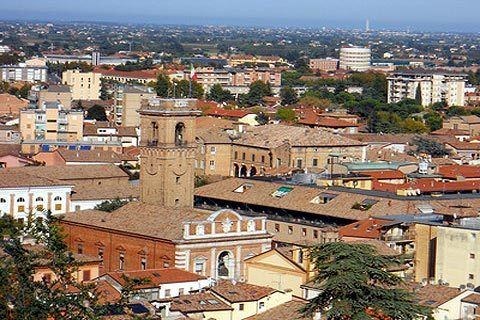Province / Metropolitan city Forlì-Cesena (FC) Elevation 44 m (144 ft) Area 249.5 km² Patron saint John the Baptist | Frazioni see list Demonym(s) Cesenati Local time Wednesday 2:13 PM | |
 | ||
Weather 14°C, Wind NE at 23 km/h, 35% Humidity | ||
Cesena ([tʃeˈzɛːna]) is a city and comune in the Emilia-Romagna region of northern Italy, south of Ravenna and west of Rimini, on the Savio River, co-chief of the Province of Forlì-Cesena. It is at the foot of the Apennines, and about 15 kilometres (9 miles) from the Adriatic Sea.
Contents
- Map of Cesena Province of ForlC3AC Cesena Italy
- Sassuolo cesena 1 2 highlights tim cup 2016 17
- History
- Main sights
- Economy
- Transport
- Neighbouring comuni
- Notable people
- Frazione
- References
Map of Cesena, Province of Forl%C3%AC-Cesena, Italy
Sassuolo cesena 1 2 highlights tim cup 2016 17
History
Cesena was originally an Umbrian or Etruscan town, later known as Caesena. After a brief spell under Gaulish rule, it was taken over by Romans in the 3rd century BC. It was a garrison town of strategic importance which was destroyed in the wars between Gaius Marius and Sulla. Pliny mentions the wines of Cesena as among the best.
Cesena was on the border that the Exarchate of Ravenna shared with the Lombards. It was presented to the Papacy by its Frankish conqueror in 754 and passed back and forth between the popes and the archbishops of Ravenna, was briefly a communal republic (1183–1198). It was then long contested between popes and Holy Roman Emperors. The brief rule by the Forlivese Ordelaffi was crushed in 1357 by Papal troops led by Cardinal Gil de Albornoz, after a long siege heroically endured by Cia degli Ordelaffi, wife of the Lord of Forlì.
The little comune revolted again in 1377 during the War of the Eight Saints. This time it was recaptured by Breton troops of Giovanni Acuto (the English-born condottiere John Hawkwood) under the command of Robert, Cardinal of Geneva, (later antipope Clement VII). The latter, acting as the legate of Pope Gregory XI, directed the savage murder of between 2,500 and 5,000 civilians. By the laws of war at the time this was regarded as an atrocity that earned the label of the "Cesena Bloodbath" and the cardinal the "butcher of Cesena". The following year what remained of Cesena was assigned by the new pope Urban VI to Galeotto I Malatesta.
During the period 1379-1465 the city recovered and prospered under the Malatesta, who rebuilt the castle (called Rocca Malatestiana) overlooking the town. The Malatestiana Library, built by near the castle by Malatesta Novello (1429), is considered a fine example of a Renaissance library and holds many valuable manuscripts.
After Novello's death (1465), Cesena returned to the Papal States, but was again seized by a local seignor, Cesare Borgia, in 1500. The city was elevated to capital of his powerful though short-lived duchy.
Cesena subsequently turned into a secondary city of the Papal States. In the 18th and 19th centuries Pope Pius VI and Pope Pius VII were born in the city, which also had Pope Pius VIII as bishop, gaining the title of "city of the three popes". During the Napoleonic Wars it was stripped of numerous monasteries and churches. Some of its citizens had notable roles in the unification of Italy, in the second half of the 19th century.
During World War II Cesena was near the Gothic Line, which ran along the Appennini near the city, and suffered heavily from bombing.
In 1992 it was elevated to the rank of co-capital of province, together with Forlì.
On July 30, 2015, 1000 people gathered at the Parco Ippodromo park in Cesena, and performed "Learn to Fly" by the Foo Fighters to convince the band to perform there. The group, later known as the Rockin' 1000, was organized by Foo Fighters fans who played the guitar, bass and drums in unison to a conductor. Dave Grohl responded with a video where he announced in Italian that the band would visit Cesena and perform there. The show was scheduled for November 3, 2015 at the town's indoor sports arena and concert venue, Carisport, becoming the kickoff date for their European tour.
Main sights
Cesena's monuments include:
Economy
The main economic sectors in Cesena are:
Notable companies based in Cesena include:
Transport
Cesena railway station, opened in 1861, forms part of the Bologna–Ancona railway. It is situated at Piazza Giorgio Sanguinetti, to the northeast of the city centre.
Neighbouring comuni
Notable people
Frazione
Acquarola, Aie, Bagnile, Borello, Borgo di Ronta, Borgo delle Rose, Borgo Paglia, Botteghino, Budrio, Bulgaria, Bulgarnò, Calisese, Calabrina, Capannaguzzo, Carpineta, Casalbono, Casale, Case Castagnoli, Case Frini, Case Gentili, Case Missiroli, Case Scuola Vecchia, Celincordia, Celletta, Diegaro, Formignano, Gattolino, Gualdo, Il Trebbo, Lizzano, Luogoraro, Luzzena, Macerone, Madonna dell'Olivo, Martorano, Massa, Molino Cento, Monte Aguzzo, Monte Vecchio, Montereale, Monticino, Oriola, Osteria di Piavola, Paderno, Pievesestina, Pioppa, Ponte Abbadesse, Ponte Pietra, Pontecucco, Provezza, Rio Eremo, Rio Marano, Ronta, Roversano, Ruffio, Saiano, San Carlo, San Cristoforo, San Demetrio, San Giorgio, San Mamante, San Martino in Fiume, San Matteo, San Tomaso, San Vittore, Santa Lucia, Sant'Andrea in Bagnolo, Settecrociari, Tessello, Tipano, Torre del Moro, Trebbo, Valdinoce, Villa Calabra, Villa Casone.
